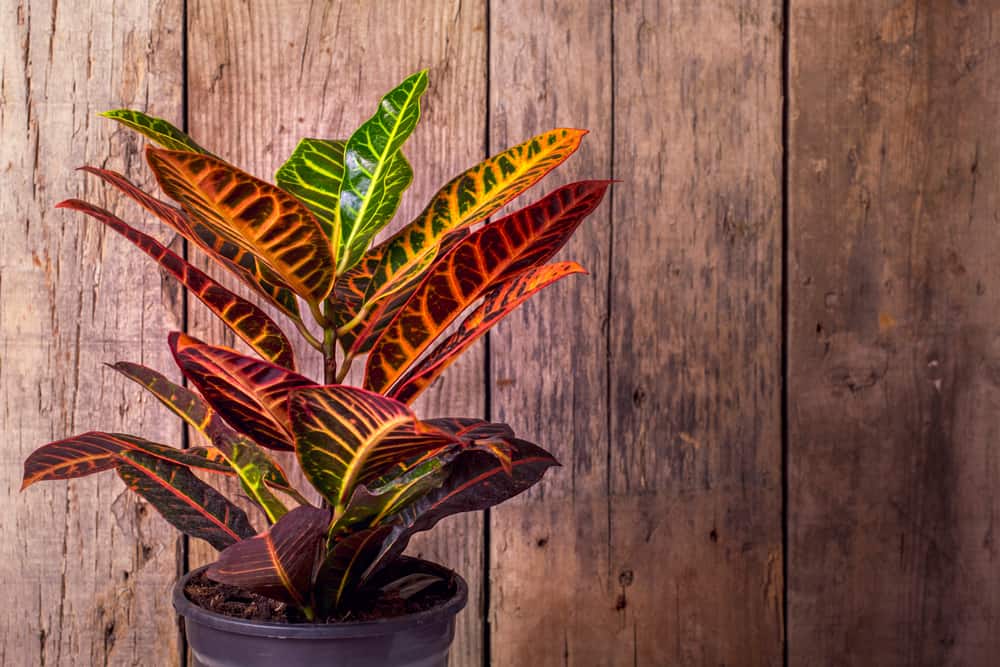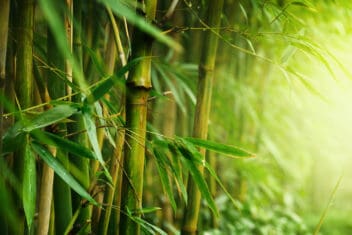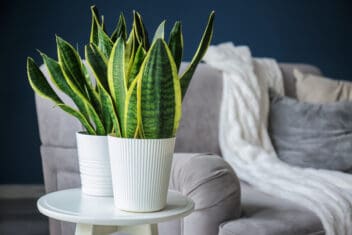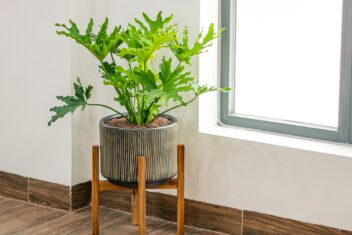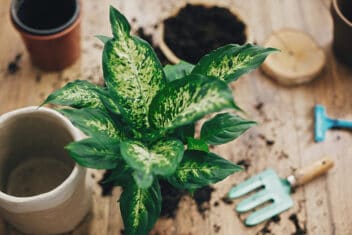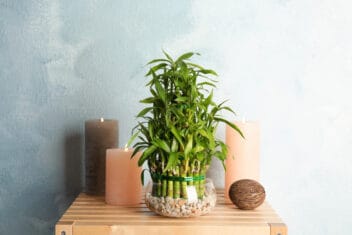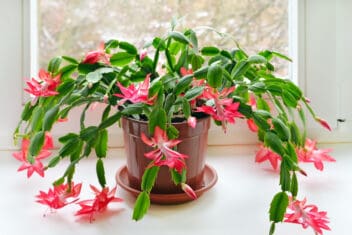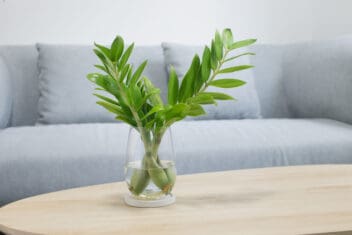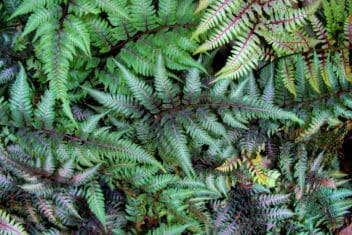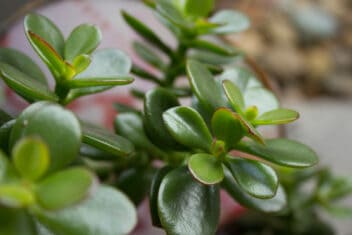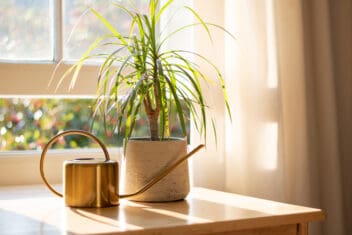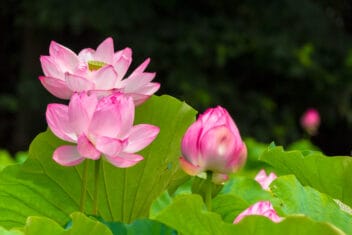If I was only able to grow one indoor plant, croton ‘Petra’ would be the one. This plant draws your eye with its vibrant red, orange, green, purple, and yellow-colored leaves.
Whether you have one plant or a group of them, it’s hard not to be impressed by this wondrous festival of colors. Once you have one croton ‘Petra,’ I have a hunch you’ll want more.
Not just because of their beauty but also because they’re fairly easy to raise. Let’s look at how you can join the croton ‘Petra’ fan club.
What is Croton ‘Petra?’
Croton ‘Petra” (Codiaeum variegatum ‘Petra’) is a colorful tropical, broadleaf evergreen native to Southern Asia and some Pacific regions. It’s a popular cultivar of the C. variegatum species, but there are others, including ‘Gold Star,’ ‘Eleanor Roosevelt,’ and ‘Oakleaf.’
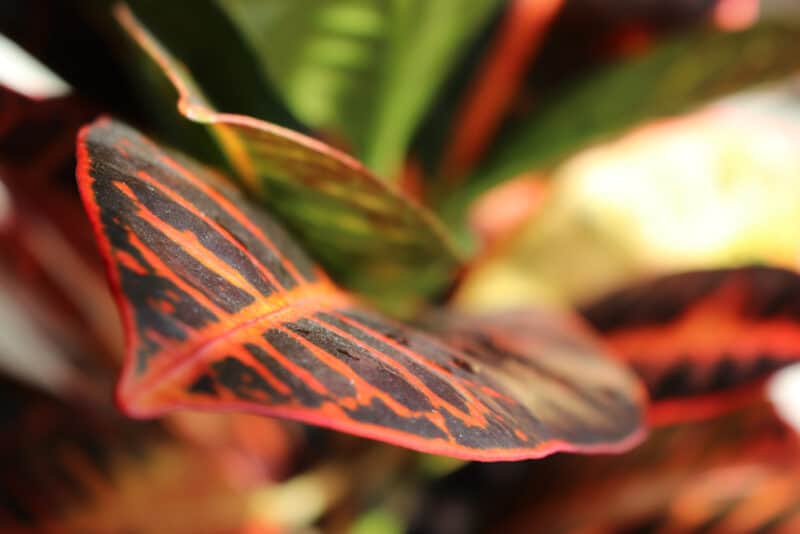
Sometimes called garden croton, or golden petra, this plant is grown in cooler areas as an indoor container plant, but in warmer areas in USDA Growing Zones 9-11, it can be grown as an outside specimen.
In their natural habitat, croton ‘Petra’ can grow as tall as 10 feet high. In containers and outside of their natural environment, they grow much smaller. Like many houseplants, the bigger the pot, the bigger the plant.
Croton ‘Petras’ are from the Euphorbiaceae family which includes cassava and many other plants found in temperate and subtropical areas of the world.
How to Propagate Croton ‘Petra’
If your friend has a plant or you live in an area where it grows wild, you can propagate your own plants. These are also good ways to create new plants out of ones you already own.
Of all the methods used to propagate croton ‘Petra,’ the easiest and most likely to succeed are the cuttings in soil or water, but don’t let that put you off of air layering.
By Stem Cuttings in Soil
I find croton ‘Petra’ responds well to stem cuttings.
To make a cutting, snip a six-inch stem with new growth at the top end using a pair of pruners. Remove the leaves from the bottom half and dip the cut end into rooting powder to encourage root formation.
Plant the cutting in a pot with a mixture of one sphagnum moss and one part perlite. Water well and place in a warm area. Place a plastic bag over the container for humidity. You can stick a chopstick into the soil to help prop the bag up. It shouldn’t touch the leaves at all.
Place the pot in a warm spot with indirect sunlight and keep the soil moist.
In about six weeks, the roots should have formed. If the plant resists when you tug it and you can see new leaves forming, that means it worked. Now you can move your new plant to its permanent home if it isn’t there already.
By Stem Cuttings in Water
You can propagate croton ‘Petra’ in water. Just remember that water roots take a bit longer to become established once you put the plant in soil than roots started in soil.
Use a slightly thicker stem cutting that’s about the thickness of a pencil. Remove the lower leaves. Place the stem in a glass of water and keep it in a warm area with indirect sunlight for five to six weeks until roots grow. You’ll need to replace the water every few days.
Plant in a pot with good quality potting soil.
Air Layering
Croton ‘Petra’ is a good candidate to propagate through air layering.
Read our in-depth article on air layering here.
How to Grow Croton ‘Petra’
You can grow croton ‘Petra’ outside as a tree or shrub if you live in USDA Growing Zones 9 to 11. Outside of those areas, you will have to grow it indoors. However, in areas with warm summers, you can also grow them in containers and overwinter the plants indoors.
The best temperature to grow this plant is 60-70ºF, but anything between 55-85ºF with only brief periods outside of this range (and never freezing) is fine.
Indoors
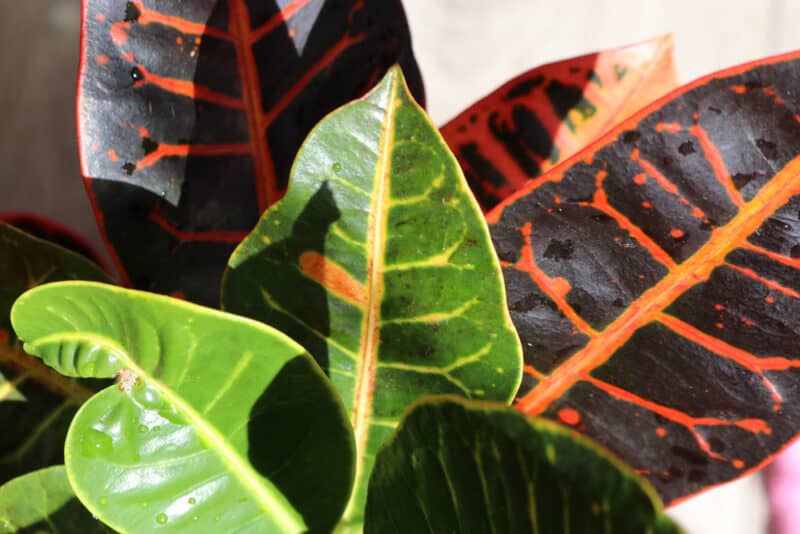
Croton ‘Petra’ is a little bit of a goldilocks plant. Things need to be just right. Not too bright, not too cool, not too dry, and not too much water.
Choose a room without drafts or sudden temperature drops from wind gusts. The room should stay somewhere be between 60-70°F. Avoid placing the plant near a vent that emits hot or cold air from the HVAC.
Provide at least four to six hours of indirect, but bright sunlight. Any less than this and the colors the plant is known for will be dull, and the leaves will remain green. The more light, the brighter the leaves will be. Too little light and the plant gets leggy and droopy. Direct sunlight will scorch the leaves.
A good quality potting soil is necessary for croton ‘Petra,’ but make sure to buy one with a pH between 4.5 and 6.5. If you make your own potting soil, don’t add too much calcium as this affects the vigor of the plant.
Water
Overwatering is a problem for croton ‘Petra.’ They love water and humidity, but standing water on the roots can cause the leaves to droop and, even worse, the roots to rot. Don’t even think about growing croton ‘Petra’ in a container without drainage.
Water the soil in the container when the top inch to inch and a half is dry. Then, water until it begins to drain from the bottom. Empty the drainage catch. Allow the soil to dry again before watering more.
Like most tropical plants, croton ‘Petra’ desires humidity. You could place the pot on a tray with pebbles, or mist the leaves daily. Allowing the humidity to drop around croton ‘Petra” can cause health problems and invite pests.
Coming from the tropics, croton ‘Petra’ loves clean, fresh water. Use filtered water or leave your water out overnight to allow the chlorine to evaporate. Do this for the misting water as well.
Fertilizer is important, but once again, it needs to be just right. Use a mix of 8-2-10, 3-1-2 fertilizer, or similar.
Use a slow-release fertilizer and water it in well. Feed once in spring and then twice in the summer. Allow the plant to rest in fall and winter.
Repot the plant when it outgrows the current container. I tend to do this every two years or so. Choose a pot that’s only about one to two inches bigger than the current one.
Loosen the roots and remove the old soil before repotting into a new container with fresh soil.
Outside
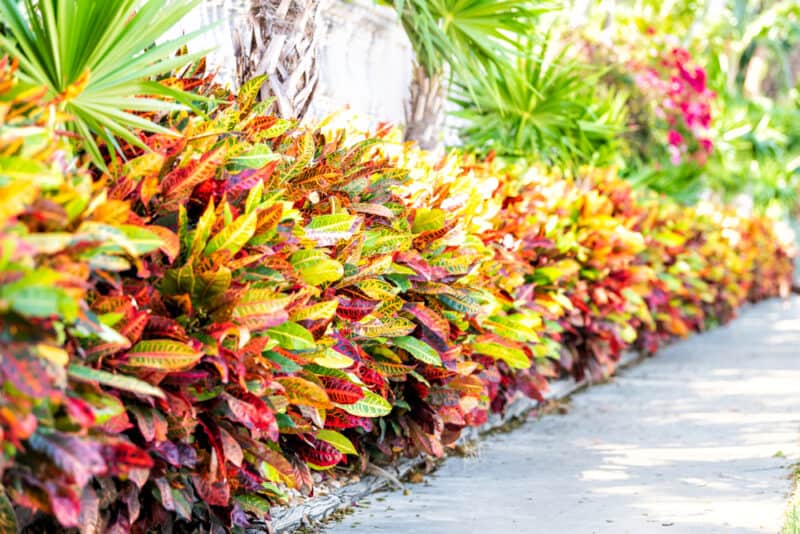
Croton ‘Petra’ looks great as a shrub border or as a hedge, or grouped together in a garden.
A site with morning sun and afternoon shade suits them well, though it’s a common sight to see them growing in full sun when outside.
Consistent temperatures between 60-70ºF are ideal. Anything below about 45ºF or above about 85*F, you will need to move it inside. Try using a smaller pot so it’s easier to move, or use a planter on wheels.
In the garden, dig in plenty of well-rotted manure before planting and water regularly.
Companion Planting for Croton ‘Petra’
Try any of these as companions for an eye-popping colorful garden.
- Marigold
- Coleus
- Angelonia
- Celosia
- Canna
- Lantana
Common Problems and Solutions for Growing Croton ‘Petra’
Most problems for croton ‘Petra’ are cosmetic issues and easily remedied.
Drooping Leaves
This is nearly always because the soil has dried out too much. Croton ‘Petra’ prefers consistently moist soil. If you forget to water your plant, you need to give it a good soaking to strengthen it.
Put about four inches of water in your basin and place the croton ‘Petra’ in its pot in the water. Don’t have the tray under the pot. Allow the water to soak up into the soil through the drainage holes of the pot for about 45 minutes.
After this time, check to see if the soil is moist a few inches down below the surface.
Leaf Drop
This could be for a number of reasons, and with croton ‘Petra,’ it often happens all of a sudden rather than slowly over time.
- Inconsistent Watering: If you water too much or not enough, and then change the consistency, croton ‘Petra’ is likely to respond by dropping its leaves.
- Too Little Humidity: Remember this is a tropical plant and it needs humidity. Mist it regularly, use pebbles in a tray underneath, or use a humidifier if you have one.
- Too Little Sun: Although croton ‘Petra’ doesn’t like full, direct sun, it does love and need light. If it doesn’t get enough, it will drop its leaves. Often if you lose leaves due to insufficient light, many of the other leaves will be dull or green and not the vibrant color when the plant is happy.
- Movement: Sometimes when you repot a plant, move its location, or transplant it, it gets a shock and drops leaves. Patience is key here. Monitor your croton ‘Petra’ and wait to see if it improves.
Leaves Become Brown and Crispy
This is a combination of insufficient water and humidity. Remedy both of those issues and you’ll see improvement.
Leaves Have Brown Spots with Yellow Edges
Salt can build up in pots from the type of water you use and from fertilizer. Flush the pot with fresh rainwater or filtered water. Be careful not to overwater when flushing. If too much salt builds up, you’ll need to repot with fresh soil.
Anthracnose
Croton ‘Petra’ is susceptible to anthracnose. Read our article here on how to identify and deal with this problem.
Edema
This is caused by overwatering. The plant tries to take on all the water you give it and it ends up with blisters on the leaves. This could lead to leaf drop.
Reduce the watering and allow the soil to dry out for the first two inches of the soil surface between watering.
Spider Mites
Spider mites attack many houseplants, especially when there is a lack of humidity. They damage foliage and can cause the plant to look dusty, which is actually fine webbing left by the mites.
Prevention is the best cure. Take a soft cloth and dampen it with neem oil. Wipe each leaf gently. Make sure you provide sufficient humidity.
For getting rid of these common pests, check out our guide.
Whiteflies
Whiteflies often appear in groups on croton ‘Petra’ plants. They cause damage and secret honeydew, which can lead to sooty mold.
Keep the leaves clean and in good health. If you have a large number of whiteflies, use neem oil, or an insecticide specific to houseplants.
